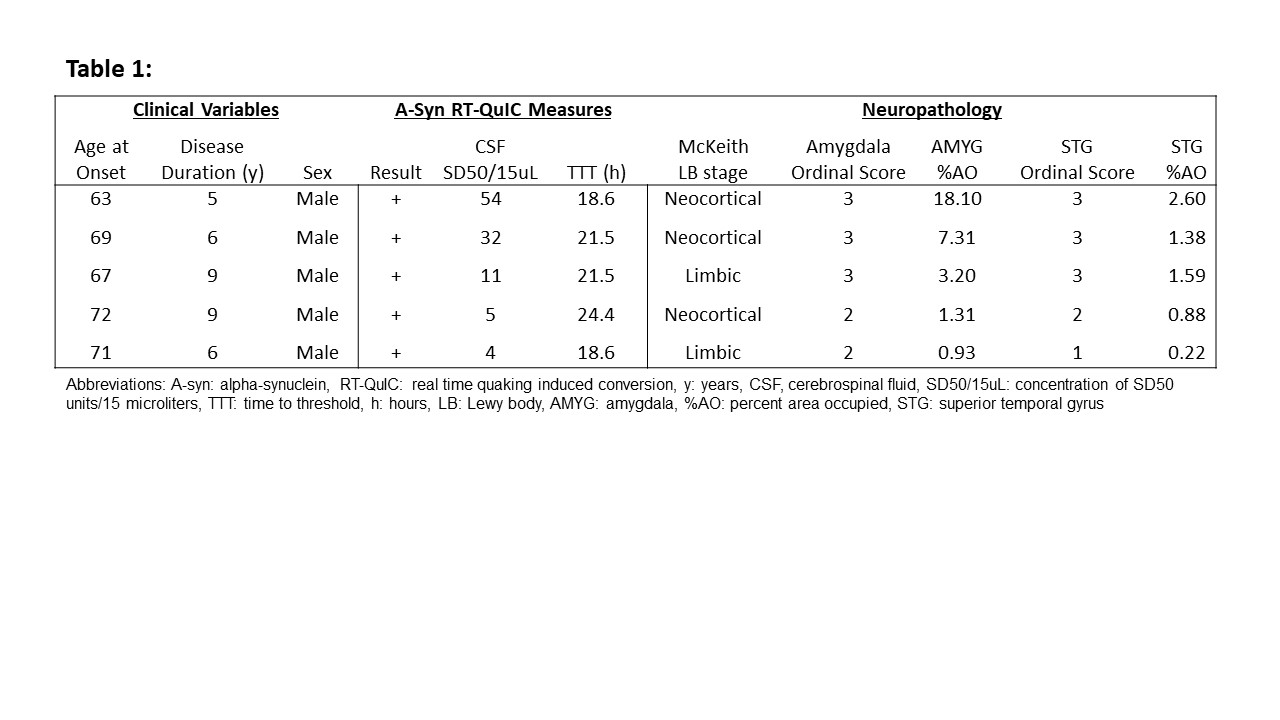Objective: To determine if measures of alpha-synuclein (a-syn) real time quaking induced conversion (RT-QuIC) activity are related to a-syn neuropathologic burden in dementia with Lewy bodies (DLB).
Background: A-syn RT-QuIC is an emerging technique that can detect pathogenic a-syn seeds from CSF samples in PD and DLB patients with high sensitivity and specificity, which may aid in increasing antemortem diagnostic accuracy [1-5]. However, it is unclear if RT-QuIC measures can be used to estimate neuropathological a-syn burden as a biological measure of disease severity.
Method: Five subjects with pathologically-confirmed DLB had antemortem CSF a-syn RT-QuIC analyzed for positivity, time to threshold (TTT), and seeding dose units present to give positive results in 50% of replicate reactions (SD50) [1]. All subjects participated in brain donation where, after staining for phospho-synuclein with 81A antibody, McKeith Lewy body stages were assigned [6]. Additionally, ordinal severity scores (0:none to 3:severe) and digital measurements of a-syn pathology (% area occupied: %AO) [7] in the amygdala and superior temporal gyrus (STG) were obtained. RT-QuIC measures were compared to Lewy body stage and ordinal pathology scores. Linear regression compared SD50 and TTT to clinical variables and a-syn%AO from amygdala and STG.
Results: Mean age of onset was 68.4y (SD 3.6) with disease duration of 7.0y (SD 1.9). All cases had positive CSF a-syn RT-QuIC. There was a trend level association of SD50 with age of onset but not with disease duration (β=-0.8 and -0.7, p=0.07 and p=0.19 respectively). We observed that higher Lewy body stages and higher ordinal pathology scores in the amygdala and STG were associated with higher a-syn RT-QuIC SD50 (Table 1). SD50 was significantly related to higher a-syn %AO in the amygdala and STG while controlling for disease duration (β=1.0, p=0.03 and β=1.3, p=0.03 respectively). TTT was not associated with a-syn burden (p>0.05).
Conclusion: In this preliminary report, we observed that higher seeding activity of CSF a-syn RT-QuIC, as measured by SD50, may associate with higher degrees of a-syn neuropathology at autopsy and may be a better approximation of pathology than time to threshold. If this finding can be replicated in larger studies, a-syn RT-QuIC may have utility not only as a categorical test for the presence of pathologic a-syn seeds but may also serve as a marker of a-syn burden in DLB.
References: [1] B.R. Groveman, C.D. Orrù, A.G. Hughson, L.D. Raymond, G. Zanusso, B. Ghetti, K.J. Campbell, J. Safar, D. Galasko, B. Caughey, Rapid and ultra-sensitive quantitation of disease-associated α-synuclein seeds in brain and cerebrospinal fluid by αSyn RT-QuIC, Acta neuropathologica communications 6(1) (2018) 7. [2] E. Saijo, B.R. Groveman, A. Kraus, M. Metrick, C.D. Orru, A.G. Hughson, B. Caughey, Ultrasensitive RT-QuIC Seed Amplification Assays for Disease-Associated Tau, alpha-Synuclein, and Prion Aggregates, Methods Mol. Biol. 1873 (2019) 19-37. [3] K. Sano, R. Atarashi, K. Satoh, D. Ishibashi, T. Nakagaki, Y. Iwasaki, M. Yoshida, S. Murayama, K. Mishima, N. Nishida, Prion-Like Seeding of Misfolded alpha-Synuclein in the Brains of Dementia with Lewy Body Patients in RT-QUIC, Mol. Neurobiol. 55(5) (2018) 3916-3930. [4] G. Fairfoul, L.I. McGuire, S. Pal, J.W. Ironside, J. Neumann, S. Christie, C. Joachim, M. Esiri, S.G. Evetts, M. Rolinski, Alpha‐synuclein RT‐Qu IC in the CSF of patients with alpha‐synucleinopathies, Annals of clinical and translational neurology 3(10) (2016) 812-818. [5] A. van Rumund, A.J. Green, G. Fairfoul, R.A. Esselink, B.R. Bloem, M.M. Verbeek, Alpha‐synuclein RT‐QuIC in the CSF of uncertain cases of parkinsonism, Ann. Neurol. (2019). [6] I.G. McKeith, B.F. Boeve, D.W. Dickson, G. Halliday, J.-P. Taylor, D. Weintraub, D. Aarsland, J. Galvin, J. Attems, C.G. Ballard, Diagnosis and management of dementia with Lewy bodies: Fourth consensus report of the DLB Consortium, Neurology 89(1) (2017) 88-100. [7] D. Coughlin, S.X. Xie, M. Liang, A. Williams, C. Peterson, D. Weintraub, C.T. McMillan, D.A. Wolk, R.S. Akhtar, H.I. Hurtig, H. Branch Coslett, R.H. Hamilton, A.D. Siderowf, J.E. Duda, K. Rascovsky, E.B. Lee, V.M. Lee, M. Grossman, J.Q. Trojanowski, D.J. Irwin, Cognitive and Pathological Influences of Tau Pathology in Lewy Body Disorders, Ann. Neurol. 85(2) (2019) 259-271.
To cite this abstract in AMA style:
D. Coughlin, C. Orru, B. Groveman, A. Hiniker, R. Rissman, B. Caughey, D. Galasko. Relationship Between a-syn RT-QuIC and a-syn Neuropathologic Burden in Dementia with Lewy Bodies [abstract]. Mov Disord. 2020; 35 (suppl 1). https://www.mdsabstracts.org/abstract/relationship-between-a-syn-rt-quic-and-a-syn-neuropathologic-burden-in-dementia-with-lewy-bodies/. Accessed January 2, 2026.« Back to MDS Virtual Congress 2020
MDS Abstracts - https://www.mdsabstracts.org/abstract/relationship-between-a-syn-rt-quic-and-a-syn-neuropathologic-burden-in-dementia-with-lewy-bodies/

